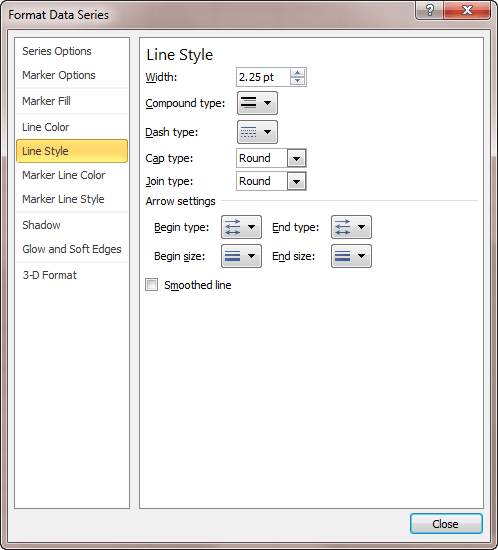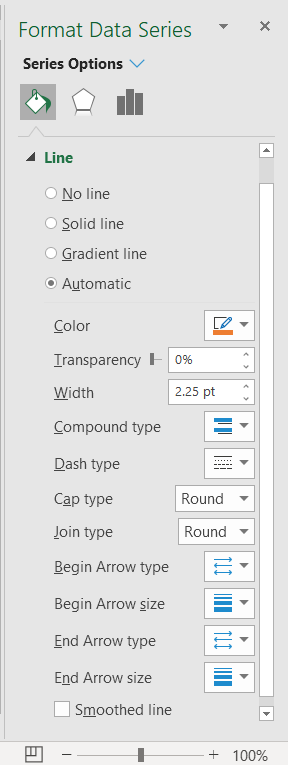Please Note: This article is written for users of the following Microsoft Excel versions: 2007, 2010, 2013, 2016, 2019, and 2021. If you are using an earlier version (Excel 2003 or earlier), this tip may not work for you. For a version of this tip written specifically for earlier versions of Excel, click here: Smoothing Out Data Series.
Written by Allen Wyatt (last updated November 26, 2024)
This tip applies to Excel 2007, 2010, 2013, 2016, 2019, and 2021
When you create line charts in Excel, the lines drawn between data points tend to be very straight. (This makes sense; the lines are meant to connect the points.) You can give your graphs a more professional look by simply smoothing out the curves Excel uses at each data point. Follow these steps if you are using Excel 2007 or Excel 2010:

Figure 1. The Line Style options of the Format Data Series dialog box.
The steps are slightly different in Excel 2013 and later versions:

Figure 2. The Line options of the Format Data Series task pane.
One final note: Just because Excel provides a way for you to smooth the lines connecting data points, that doesn't always mean that you should. Make sure you give some thought to what conclusions people may draw from your data. If the data in the chart is more precise with unsmoothed lines, then you should probably not smooth them. You want to avoid misrepresenting your data or causing readers to draw incorrect conclusions.
ExcelTips is your source for cost-effective Microsoft Excel training. This tip (9510) applies to Microsoft Excel 2007, 2010, 2013, 2016, 2019, and 2021. You can find a version of this tip for the older menu interface of Excel here: Smoothing Out Data Series.

Best-Selling VBA Tutorial for Beginners Take your Excel knowledge to the next level. With a little background in VBA programming, you can go well beyond basic spreadsheets and functions. Use macros to reduce errors, save time, and integrate with other Microsoft applications. Fully updated for the latest version of Office 365. Check out Microsoft 365 Excel VBA Programming For Dummies today!
Need to generate a chart in the fastest possible way? Just use this shortcut key and you'll have one faster than you can ...
Discover MoreGridlines are often added to charts to help improve the readability of the chart itself. Here's how you can control ...
Discover MoreTitles can be a great addition to any chart. They help provide explanatory information about the information in the ...
Discover MoreFREE SERVICE: Get tips like this every week in ExcelTips, a free productivity newsletter. Enter your address and click "Subscribe."
There are currently no comments for this tip. (Be the first to leave your comment—just use the simple form above!)
Got a version of Excel that uses the ribbon interface (Excel 2007 or later)? This site is for you! If you use an earlier version of Excel, visit our ExcelTips site focusing on the menu interface.
FREE SERVICE: Get tips like this every week in ExcelTips, a free productivity newsletter. Enter your address and click "Subscribe."
Copyright © 2025 Sharon Parq Associates, Inc.
Comments